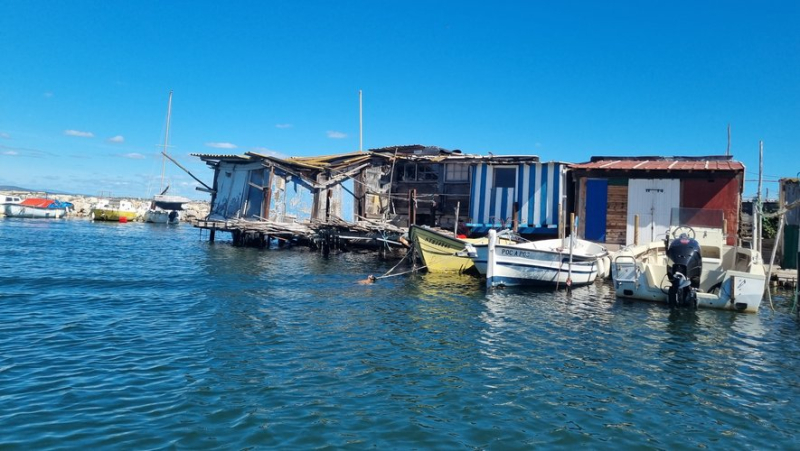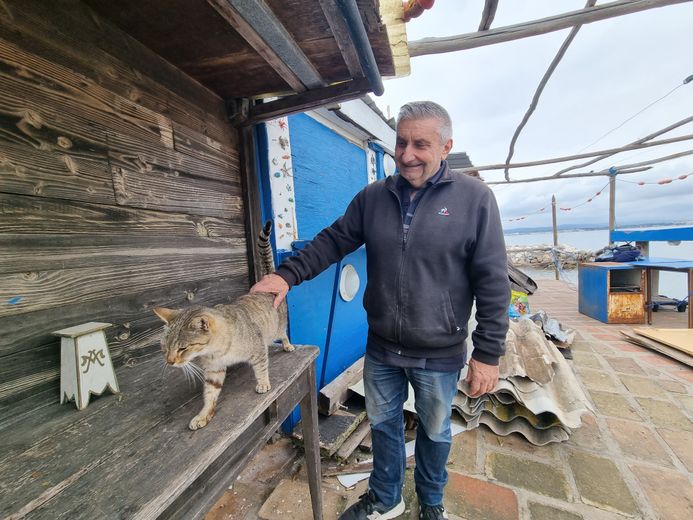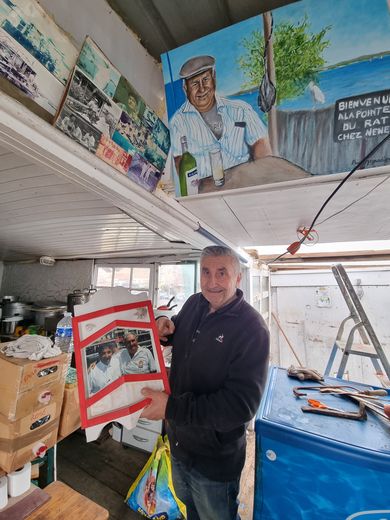Sète heritage: the timeless charm of the Pointe Courte cabins

Some typical cabins of the Pointe were erected on stilts, on platforms where fishermen stored their “paus” (poles). Hélène Amirals

Avant la construction du quai, les barques amarrées sur la plage. D.R
For fishing or family meals, they are the soul of the small neighborhood port.
With its blue and white exterior and its pointed nose, the “Chez Néné” is perhaps one of the most photogenic in Pointe Courte. It is she who seems to close the tiny fishing port, when we ride in a sapinou towards the Etang de Thau. The hut of odds and ends stands at the end of this "adorable mess", as described by Pascal Nadal, in the book “La Pointe Courte”, signed Jean-Loup Gautreau. A little askew since it took its place at the end of the Georges Brassens dike in the 90s, renamed the “Pointe du Rat”. Cat paradise.

Sylvain Sabatier accomplice with “the noble cat” Coyotus. Hélène Amirals
“Chez Néné”, the kingdom of Coyotus
Sylvain Sabatier lovingly maintains the cabin built by his parents at “Pointe du Rat”, when they lived in the neighborhood before moving to the city. She is full of memories, like her father's jousting trophies, “Néné”.
Like all the wooden huts in the port, it is very fragile under the effect of the vagaries of nature.
So, Sylvain takes great care to pamper, repaint and renovate the shelter every year. A pleasure for Sylvain who likes to spend time on this piece of dike at Pointe Courte, "a remarkable site". But it’s not just him. The cats have also taken up residence there, they too have their cabin. One in particular, who particularly appreciates the pontoon of “Chez Néné”.
"I called him Coyotus. He's brave as hell. It's a crusader, an alley Abyssinian, a noble cat". The king of “Pointe du Rat”.
Chez “Néné”
The Pointe Courte dike, in its current form, was taken over the pond thanks to the embankments from the construction of the railway line linking Tarascon to Bordeaux, built in the middle of the 19th century (1839-1850). But the first fishermen from Quai de la Bordigue settled on this piece of land, opposite La Plagette, as early as the 17th century. In makeshift sheds. Some had even built there on stilts to directly access the fish resource (read opposite). The neighborhood was born. But it belonged to Frontignan until 1805.
In 1871, 26 families or around a hundred inhabitants lived on this maritime domain of the State. If most of the cabins have become permanent houses, the wooden cabins still remain at the water's edge and on the Brassens dike.
Michel Brel: “It’s the history of the neighborhood”
He has Short Point in his skin and in his heart. Michel Brel has almost become its official historian. He even dedicated one of his books to it, “Au coeur de ma Pointe Courte”. For him, the neighborhood child, the cabins are a precious and moving testimony to his history.
"La Pointe was initially just cabins for fishermen's equipment, he recalls. My great-grandfather built one around 1915. Then, when they became habitable, the Pointus ran out of space. Others had to be built for the equipment.
Sapinous, wooden nacelles or even “négafols” for clam fishing (artisanal box fishing), were stationed in front. The first installations of this kind, on the beach side of the port, appeared in the 1970s along the bowling alley.
Some, like “Chez Néné”, have the particularity of being mounted on stilts. These are platforms where small trades, at the end of each campaign, deposit their “paus” (chestnut wood stakes), stacking them on rails. « They were used to hold the nets against the current in the pond. There were several types: “capetchades” for the shallow depth, the “posts of the manners” and triangles », likes to describe Michel Brel.
"There were still around a hundred fishermen in the 80s". The latter have largely disappeared, along with wild shellfish. Today, half of these shelters (there were even some for toilets) are still used to store and “ramender” (repair) the fishing meshes. The others host family meals.
"For me, these cabins are the heritage of the Point, a precious testimony of the past".< /p>
They give the Pointe much sought-after character. In their original state, as they say, they still serve, for the most part, to house the equipment of the neighborhood's fishermen. Others are lovingly preserved by their descendants to receive their friends. Like “Chez Néné”.
This cabin on the water, where some personalities passing through Singulière Island, like Julien Doré or Renaud, like to dock in complete discretion, once belonged to René Sabatier, known as “Néné”. A shellfish farmer and fisherman at the pond, well known at La Pointe for his five French titles of Sète jousting champion. An outstanding card and boules player according to his friend Michel Brel: "Panisse next door, it was nothing at all!"< /em>

Sylvain Sabatier under the gaze of his father René painted by Eric Meynadier. Hélène Amirals
At the entrance to the hut, sits his colorful portrait, signed by the Balaru artist Éric Meynadier. "He painted many people from the neighborhood", says “Néné”'s son, Sylvain, a former dockworker, told him also a figure in the neighborhood, who strives to preserve the place. He often accompanied his father to the pond to help him bring up sea bass, sea bream and eels.
Carmen's Maca
In September 2023, a few piles gave way under the weight of time, taking away part of the construction. But Sylvain wouldn't let this little house go to the bottom for anything in the world. The pontoon where his father moored his pod (small boat), and dried his nets on the “cabers” (dryers). He hung ropes there to grow some oysters and mussels, and put his goods “to temper”.
The elegant bed of daisies, laid out on the pontoon, was the work of his mother Carmen. The “Pointe du Rat” is especially where the family and friends of “Néné” came to taste the famous "maca de la mer" of Carmen. And of which Sylvain has particularly fond memories. "Stuffed squid, stuffed mussels, dried rouille, the aioli binding, she had her knack", confides Sylvain who continues the tradition for his friends. A little bit of the soul of the Pointe is still there.
I subscribe to read more




